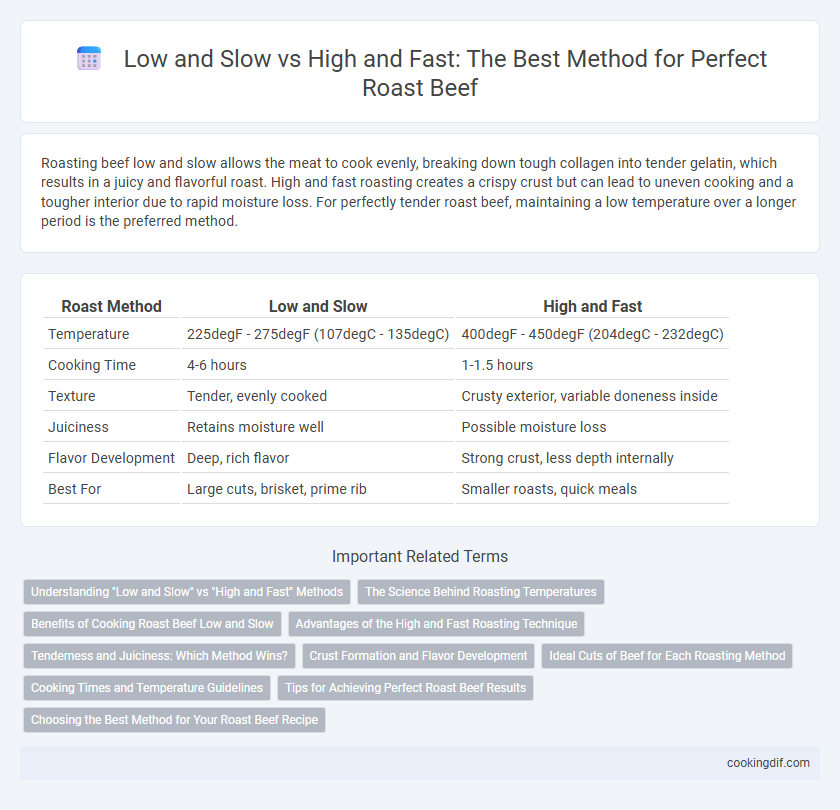Roasting beef low and slow allows the meat to cook evenly, breaking down tough collagen into tender gelatin, which results in a juicy and flavorful roast. High and fast roasting creates a crispy crust but can lead to uneven cooking and a tougher interior due to rapid moisture loss. For perfectly tender roast beef, maintaining a low temperature over a longer period is the preferred method.
Table of Comparison
| Roast Method | Low and Slow | High and Fast |
|---|---|---|
| Temperature | 225degF - 275degF (107degC - 135degC) | 400degF - 450degF (204degC - 232degC) |
| Cooking Time | 4-6 hours | 1-1.5 hours |
| Texture | Tender, evenly cooked | Crusty exterior, variable doneness inside |
| Juiciness | Retains moisture well | Possible moisture loss |
| Flavor Development | Deep, rich flavor | Strong crust, less depth internally |
| Best For | Large cuts, brisket, prime rib | Smaller roasts, quick meals |
Understanding "Low and Slow" vs "High and Fast" Methods
The "Low and Slow" method for roast beef involves cooking at a lower temperature, usually between 225degF and 275degF, allowing the meat to become tender and retain moisture through a gradual breakdown of collagen. In contrast, the "High and Fast" approach uses temperatures around 400degF to 450degF, searing the exterior quickly to lock in juices but risking a tougher texture if overcooked. Choosing between these methods depends on the desired texture, with "Low and Slow" ideal for a tender, evenly cooked roast and "High and Fast" best for a crispy crust and faster cooking time.
The Science Behind Roasting Temperatures
Roast beef cooked low and slow at temperatures around 225-275degF promotes even collagen breakdown, resulting in tender, juicy meat due to prolonged heat exposure. High and fast roasting at temperatures above 400degF creates a caramelized crust through Maillard reactions but risks uneven cooking and tougher texture inside. Optimal roasting balances time and temperature to achieve desired doneness while maximizing flavor development and moisture retention.
Benefits of Cooking Roast Beef Low and Slow
Cooking roast beef low and slow ensures even heat penetration, resulting in tender, juicy meat with enhanced flavor development through gradual collagen breakdown. This method minimizes moisture loss, preserving the roast's natural succulence and creating a melt-in-your-mouth texture. Low and slow roasting also allows for better control of internal temperature, reducing the risk of overcooking and ensuring optimal doneness throughout the beef.
Advantages of the High and Fast Roasting Technique
High and fast roasting of beef enhances Maillard reaction, creating a deeply caramelized crust that locks in juices and intensifies flavor. This technique reduces cooking time significantly, preserving the meat's natural tenderness and resulting in a juicy, flavorful roast. Elevated temperatures also promote even browning and a desirable crispy exterior, satisfying texture preferences for many roasting enthusiasts.
Tenderness and Juiciness: Which Method Wins?
Low and slow roasting enhances tenderness and juiciness by breaking down connective tissues over extended cooking time, resulting in a succulently tender roast beef. High and fast roasting locks in juices quickly but often yields a firmer texture with less overall moisture retention. For optimal tenderness and juiciness, low and slow roasting remains the preferred method among culinary experts.
Crust Formation and Flavor Development
Low and slow roasting promotes even crust formation by allowing Maillard reactions to develop gradually, resulting in a deeply caramelized exterior and enhanced savory flavors. High and fast roasting intensifies the crust formation quickly, often creating a more pronounced sear but can risk uneven cooking and less tender meat. The balance between temperature and time is critical for optimizing both crust texture and complex flavor profiles in roast beef.
Ideal Cuts of Beef for Each Roasting Method
Ideal cuts of beef for low and slow roasting include tougher, well-marbled cuts like chuck roast, brisket, and rump roast, as their collagen breaks down over long cooking times, resulting in tender and flavorful meat. High and fast roasting suits leaner, tender cuts such as ribeye, strip loin, or tenderloin, which cook quickly at high temperatures to develop a flavorful crust without drying out. Selecting the right cut for each roasting method ensures optimal texture and flavor in the finished roast beef.
Cooking Times and Temperature Guidelines
Roast beef cooked low and slow at temperatures between 225degF and 275degF ensures even heat penetration and tender, juicy results over several hours, typically 3 to 6 hours depending on the size. High and fast roasting at 400degF or higher significantly reduces cooking time to around 1 to 1.5 hours but risks uneven cooking and less tender meat. Optimal roast beef texture and flavor come from balancing temperature and time, favoring low and slow methods for tougher cuts.
Tips for Achieving Perfect Roast Beef Results
Roasting beef low and slow at temperatures around 225-275degF ensures tender, evenly cooked meat with minimal moisture loss, ideal for tougher cuts requiring longer cooking times. High and fast roasting at 425degF or above creates a flavorful crust quickly while keeping the inside juicy, suitable for tender cuts like ribeye or sirloin. To achieve perfect roast beef, use a meat thermometer to monitor internal temperature--target 130degF for medium-rare--and let the roast rest for 15-20 minutes to retain juices.
Choosing the Best Method for Your Roast Beef Recipe
Choosing the best method for roast beef depends on the cut and desired tenderness; low and slow roasting at 225-275degF promotes even cooking and breaks down connective tissues, resulting in a juicy, tender roast. High and fast roasting at temperatures above 400degF creates a flavorful crust through Maillard reaction but may yield a less tender interior unless properly monitored. For thicker, tougher cuts like chuck roast or brisket, low and slow is ideal, while premium cuts like ribeye or tenderloin benefit from high and fast methods to maximize flavor and texture.
Low and slow vs high and fast for roast beef Infographic

 cookingdif.com
cookingdif.com